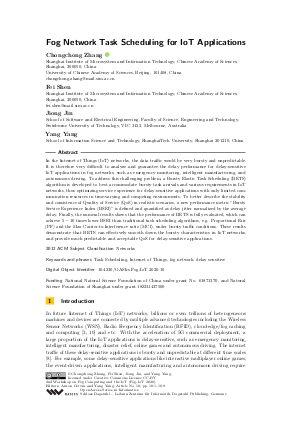Fog Network Task Scheduling for IoT Applications
Authors
Chongchong Zhang  ,
Fei Shen,
Jiong Jin,
Yang Yang
,
Fei Shen,
Jiong Jin,
Yang Yang
-
Part of:
Volume:
2nd Workshop on Fog Computing and the IoT (Fog-IoT 2020)
Part of: Series: Open Access Series in Informatics (OASIcs)
Part of: Conference: Workshop on Fog Computing and the IoT (Fog-IoT) - License:
 Creative Commons Attribution 3.0 Unported license
Creative Commons Attribution 3.0 Unported license
- Publication Date: 2020-04-08
File

PDF
OASIcs.Fog-IoT.2020.10.pdf
- Filesize: 0.56 MB
- 9 pages
Document Identifiers
Subject Classification
ACM Subject Classification
- Networks
Keywords
- Task Scheduling
- Internet of Things
- fog network
- delay sensitive
Metrics
- Access Statistics
-
Total Accesses (updated on a weekly basis)
0PDF Downloads0Metadata Views
Abstract
In the Internet of Things (IoT) networks, the data traffic would be very bursty and unpredictable. It is therefore very difficult to analyze and guarantee the delay performance for delay-sensitive IoT applications in fog networks, such as emergency monitoring, intelligent manufacturing, and autonomous driving. To address this challenging problem, a Bursty Elastic Task Scheduling (BETS) algorithm is developed to best accommodate bursty task arrivals and various requirements in IoT networks, thus optimizing service experience for delay-sensitive applications with only limited communication resources in time-varying and competing environments. To better describe the stability and consistence of Quality of Service (QoS) in realistic scenarios, a new performance metric "Bursty Service Experience Index (BSEI)" is defined and quantified as delay jitter normalized by the average delay. Finally, the numeral results shows that the performance of BETS is fully evaluated, which can achieve 5-10 times lower BSEI than traditional task scheduling algorithms, e.g. Proportional Fair (PF) and the Max Carrier-to-Interference ratio (MCI), under bursty traffic conditions. These results demonstrate that BETS can effectively smooth down the bursty characteristics in IoT networks, and provide much predictable and acceptable QoS for delay-sensitive applications.
Cite As Get BibTex
Chongchong Zhang, Fei Shen, Jiong Jin, and Yang Yang. Fog Network Task Scheduling for IoT Applications. In 2nd Workshop on Fog Computing and the IoT (Fog-IoT 2020). Open Access Series in Informatics (OASIcs), Volume 80, pp. 10:1-10:9, Schloss Dagstuhl – Leibniz-Zentrum für Informatik (2020)
https://doi.org/10.4230/OASIcs.Fog-IoT.2020.10
BibTex
@InProceedings{zhang_et_al:OASIcs.Fog-IoT.2020.10,
author = {Zhang, Chongchong and Shen, Fei and Jin, Jiong and Yang, Yang},
title = {{Fog Network Task Scheduling for IoT Applications}},
booktitle = {2nd Workshop on Fog Computing and the IoT (Fog-IoT 2020)},
pages = {10:1--10:9},
series = {Open Access Series in Informatics (OASIcs)},
ISBN = {978-3-95977-144-3},
ISSN = {2190-6807},
year = {2020},
volume = {80},
editor = {Cervin, Anton and Yang, Yang},
publisher = {Schloss Dagstuhl -- Leibniz-Zentrum f{\"u}r Informatik},
address = {Dagstuhl, Germany},
URL = {https://drops.dagstuhl.de/entities/document/10.4230/OASIcs.Fog-IoT.2020.10},
URN = {urn:nbn:de:0030-drops-120049},
doi = {10.4230/OASIcs.Fog-IoT.2020.10},
annote = {Keywords: Task Scheduling, Internet of Things, fog network, delay sensitive}
}
Author Details
- Shanghai Institute of Microsystem and Information Technology, Chinese Academy of Sciences, Shanghai, 200050, China
- University of Chinese Academy of Sciences, Beijing, 101408, China
- Shanghai Institute of Microsystem and Information Technology, Chinese Academy of Sciences, Shanghai, 200050, China
- School of Software and Electrical Engineering, Faculty of Science, Engineering and Technology, Swinburne University of Technology, VIC 3122, Melbourne, Australia
Funding
National Natural Science Foundation of China under grant No. 61871370, and Natural Science Foundation of Shanghai under grant 18ZR1437500
References
-
Najah Abu-Ali, Abd Elhamid M. Taha, Mohamed Salah, and Hossam Hassanein. Uplink scheduling in LTE and LTE-Advanced: Tutorial, survey and evaluation framework. IEEE Communications Surveys & Tutorials, 16(3):1239-1265, 3rd quarter 2014.

-
Samaresh Bera, Sudip Misra, Sanku Kumar Roy, and Mohammad S. Obaidat. Soft-WSN: Software-defined WSN management system for IoT applications. IEEE Systems Journal, PP(99):1-8, 2016.

-
Mung Chiang, Sangtae Ha, I Chih-Lin, Fulvio Risso, and Tao Zhang. Clarifying fog computing and networking: 10 questions and answers. IEEE Communications Magazine, 55(4):18-20, April 2017.

-
E. Liu and K. K. Leung. Proportional fair scheduling: Analytical insight under Rayleigh fading environment. In 2008 IEEE Wireless Communications and Networking Conference, pages 1883-1888, March 2008.

-
R. Margolies, A. Sridharan, V. Aggarwal, R. Jana, N. K. Shankaranarayanan, V. A. Vaishampayan, and G. Zussman. Exploiting mobility in proportional fair cellular scheduling: Measurements and algorithms. IEEE/ACM Transactions on Networking, 24(1):355-367, February 2016.

-
Solmaz Niknam, Ali Arshad Nasir, Hani Mehrpouyan, and Balasubramaniam Natarajan. A multiband OFDMA heterogeneous network for millimeter wave 5G wireless applications. IEEE Access, 4(99):5640-5648, 2017.

-
Wiroonsak Santipach, Kritsada Mamat, and Chalie Charoenlarpnopparut. Outage bound for max-based downlink scheduling with imperfect CSIT and delay constraint. IEEE Communications Letters, 20(8):1675-1678, August 2016.

-
Philipp Schulz, Maximilian Matthe, Henrik Klessig, Meryem Simsek, Gerhard Fettweis, Junaid Ansari, Shehzad Ali Ashraf, Bjoern Almeroth, Jens Voigt, and Ines Riedel. Latency critical IoT applications in 5G: Perspective on the design of radio interface and network architecture. IEEE Communications Magazine, 55(2):70-78, February 2017.

-
A. Sivanathan, D. Sherratt, H. H. Gharakheili, A. Radford, C. Wijenayake, A. Vishwanath, and V. Sivaraman. Characterizing and classifying IoT traffic in smart cities and campuses. In 2017 IEEE Conference on Computer Communications Workshops (INFOCOM WKSHPS), pages 559-564, May 2017.

-
Yang Yang. Multi-tier computing networks for intelligent IoT. Nature Electronics, 2(1):4-5, January 2019.

-
Yang Yang, Jing Xu, Guang Shi, and Cheng-Xiang Wang. 5G Wireless Systems. Springer, 2018.

-
Z. Zhang, C. Jiao, and C. Zhong. Impact of mobility on the uplink sum rate of MIMO-OFDMA cellular systems. IEEE Transactions on Communications, 65(10):4218-4231, October 2017.

